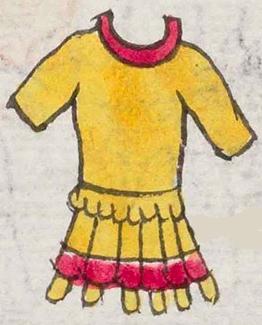cozohuipilli (Mdz13r)
This simplex glyph is really rather complex, standing for the place name Cozohuipilecan, for cozotl) (yellow parrot), huipilli (blouse or tunic), and, here, cozohuipilli (yellow parrot [feather] garment. We would consider it a compound glyph for all these morphemes, but the visual is a simplex, fusing multiple elements together. They would be difficult to atomize. The garment is primarily yellow. The neck line has red trim. The texturing of the feathers much less pronounced on the upper part of this tunic as compared to the other cozohuipilli in the collection. Below the horizontal waistband are some longer parrot feathers hanging down over what would be the lower body and upper thighs.
Stephanie Wood
The yellow parrot feather tunic would appear to have been a male warrior garment if we look to the section of the Codex Mendoza where the tributes in warrior costumes appear (folio 36 recto and forward). Thus, the term huipilli is not necessarily tied to a woman's blouse, as it is more commonly associated today.
Stephanie Wood
c. 1541, but by 1553 at the latest
Stephanie Wood
tunics, garments, prendas, trajes, tlahuiztli, feathers, plumas

cozohuipil(li), yellow parrot feather tunic, https://nahuatl.wired-humanities.org/content/cozohuipilli
Codex Mendoza, folio 13 recto, https://digital.bodleian.ox.ac.uk/objects/2fea788e-2aa2-4f08-b6d9-648c00..., image 36 of 188.
Original manuscript is held by the Bodleian Libraries, University of Oxford, MS. Arch. Selden. A. 1; used here with the UK Creative Commons, “Attribution-NonCommercial-ShareAlike 3.0 License” (CC-BY-NC-SA 3.0)

